
|
| |
 |



Electroacupuncture alleviates side effects of anti-cancer drugs by 50%
The research team led by Dr. Ryu Yeon-hee at Korea Institute of Oriental Medicine (KIOM) has proven, in a joint research with the research team led by Professor Kim Hyeon-woo at Chungnam National University School of Medicine, that electroacupuncture treatment relieves neuropathic pain, a side effect of anti-cancer drugs, by about 50%.
Dr. Ryu's team repeatedly administered paclitaxel (PTX), an anti-cancer drug commonly used in animal tests, into the abdominal cavity of test mice at 4mg/kg for five days.
The research team discovered that neural pain was maintained at a certain level starting from three days after the administration of PTX. While giving no treatment to the control group, the team carried out acupuncture treatment on the experimental group on the ST36 acupuncture point(Joksamli). After that, the team assessed pain based on physical allodynia and hyperalgesia.
Assessment of physical allodynia was made by measuring the frequency of mice's action of raising their feet in response to certain stimulation on the soles of their feet, and assessment of hyperalgesia was made by measuring the duration of their endurance of heat shock administered on the soles of their feet.

The result of assessment of physical allodynia showed that the frequency of feet raising in the experimental group was about 50% less than that of the control group. The result of assessment of hyperalgesia indicated that the duration of endurance of heat shock increased by around 20% in the experimental group compared to the control group.
The research team also proved in the action mechanism verification test that electroacupuncture treatment alleviated pain by activating neuro-transmission system that inhibits pain (opoid, adrenalin).
With the publication of the research result in the February issue of American Journal of Chinese Medicine (IF 2.755), an SCI(E)-level international academic journal in the field of complementary and alternative medicine, the research team has acquired scientific basis for the effectiveness of the treatment along with verification of the possible improvement of the quality of life of cancer patients around the world.


Dangguijagyagsan( ), Good News for Menopausal Women ), Good News for Menopausal Women
Dr. Ko Byoung Seob's research team at Korea Institute of Oriental Medicine (KIOM) found evidence that Dangguijagyagsan( ), one of the most popular prescriptions for women in Korean medicine, can improve blood flow in menopausal women. ), one of the most popular prescriptions for women in Korean medicine, can improve blood flow in menopausal women.
Through animal testing, Dr. Ko and his team proved that Dangguijagyagsan lowers thrombus formation by about 1.9 times, and improved blood flow.
* According to the 'Donguibogam', Dangguijagyagsan is made of various medicinal herbs, such as Atractylodes Rhizome, Atractylodes macrocephala Koidzumi, Angelica gigas Nakai, Paeonia Japonica, Astragali Radix, Citri unshii Pericarpium, Rehmanniae radix preparata, Baked Glycyrrhiza uralensis, Rehmanniae radix crudus, and Bupleuri radix, and is used to treat women experiencing extreme fatigue and tiredness from menorrhagia.
Dr. Ko and his team performed ovariectomy in laboratory rats to induce menopause. Then the ovariectomized rats were divided, where one group was orally administered 100 mg/kg of Dangguijagyagsan daily for 5 weeks. Then the research team induced thrombus formation and measured how long it took for thrombus formation in both groups.
As a result, it took about 7 minutes for the ovariectomized rats to form a thrombus whereas the Dangguijagyagsan-administered rats took about 13 minutes, confirming that Dangguijagyagsan lowers thrombus formation by about 1.9 times and improved blood flow.
When a thrombus occurs in a blood vessel, collagen fibers within vessel walls are damaged. Taking this into consideration, the team observed collagen fiber damage through Masson's Trichrome for collagen fiber staining.
The result showed that despite collagen fiber damage due to thrombus formation, the Dangguijagyagsan-administered rats showed collagen fibers in blood vessels, proving the protective effect of Dangguijagyagsan on blood vessels.
The team also collected blood samples and separated platelet-rich plasma to measure platelet aggregation. The result showed that the rate of platelet aggregation in the Dangguijagyagsan-administered rats was about 1.5 times lower than in the ovariectomized rats.

In addition, when the serum lipid levels were measured, the level of triglyceride (TG), total cholesterol (TC), and LDL-cholesterol, which we know as the bad kind, in Dangguijagyagsan-administered rats reduced by 10%, 20%, 15%, respectively.

* TG, TC, and LDL-cholesterol (low density lipoprotein) increase the risk of a heart attack or stroke, whereas HDL-cholesterol (high density lipoprotein) lowers the risk.
The research, which proved the benefit of Dangguijagyagsan on blood flow during menopause, provided scientific grounds to prevent and treat menopause symptoms.
"As Korea's population is aging at a fast pace, women are paying attention to healthy senior lifestyles, and I believe Dangguijagyagsan will be used widely to treat menopause symptoms," Dr. Ko said, "Now that we have scientifically proven the effectiveness of Korean medicine, we will carry on with additional mechanism research for the new value of Korean Medicine."

Sasang Constitution Analysis Tool 2(SCAT 2) Launched with Reinforced Clinical Decision Supporting System
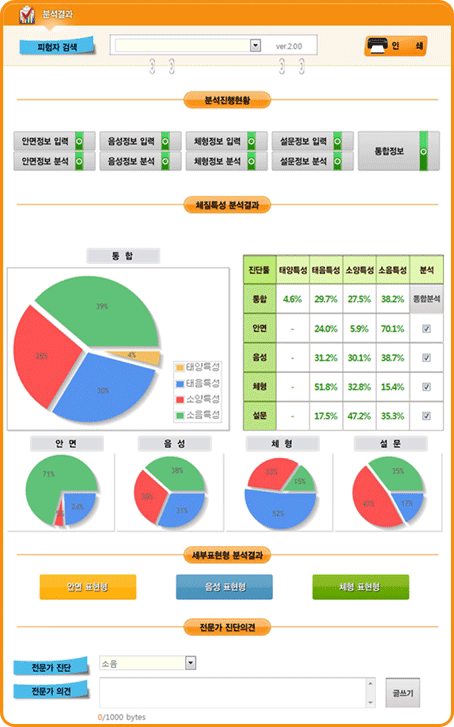 |
 |
The new Sasang Constitution Analysis Tool (SCAT2), which helps Korean medicine doctors to diagnose people's Sasang constitution by providing systemized and quantified values through their facial, vocal, and body features, has been developed by the research team of Dr. Kim Jong-yeol at Korea Institute of Oriental Medicine (KIOM).
SCAT2 systemizes and quantifies the characteristics of a person in comparison with the overall population or other people in the same age group based on the values of his or her facial, vocal, and body features obtained using the device. This way, SCAT2 reinforces the Clinical Decision Supporting System that helps doctors of Korean medicine to determine people's physical constitution.
* Sasang Constitution Analysis Tool (SCAT) is an analysis tool that enables objective diagnosis of Sasang constitution using four different kinds of data including facial image data, body shape measurement data, vocal analysis data and questionnaire data. In the past, determination of Sasang constitutional types, Taeyang, Taeeum, Soyang and Soeum, was made based on subjective judgment by doctors of Korean medicine. SCAT was first introduced by KIOM in 2010. |
* Clinical Decision Supporting System (CDSS) is a system that provides necessary information to doctors of Western or Korean medicine when they make decisions concerning treatment, prescription, etc. and help them make the appropriate treatment.
In Sasang constitutional medicine, physical constitutional types are diagnosed based on facial and vocal features, body shape and questionnaire data, and it is known that a person possesses some aspects of each constitutional type rather than having only the characteristics of a single constitutional type.
SCAT2 makes analysis based on the physical information of around 3,000 people nationwide, whose consitutional types have already been diagnosed by experts. The tool provides numerical comparison of a person's facial features, vocal features, and degree of development of different body parts with those of the overall population and other people in the same age group.
Concerning facial features, certain feature points are automatically spotted on the facial photograph and used for the analysis of physical constitution. Based on the measured values of these feature points, the shapes of the person's face, eyes, forehead, and nose as well as the sizes of his/her face, eyes and nose are shown in comparison with the data for the entire population.
In case of vocal features, the measured values of the person's recorded voice are presented in percentiles (0 to 100) relative to the entire population and other people in the same age group in terms of clarity, depth, and softness.
In addition, the timing of the analysis has been reduced to within 2 seconds after recording from within 10 seconds in the past, and the number of measurement variables from the recording environment has been cut to increase measurement stability.
Body shape features are also shown in percentiles relative to the entire population and other people in the same age group, according to the measured values of circumferences of chest, waist and hip.
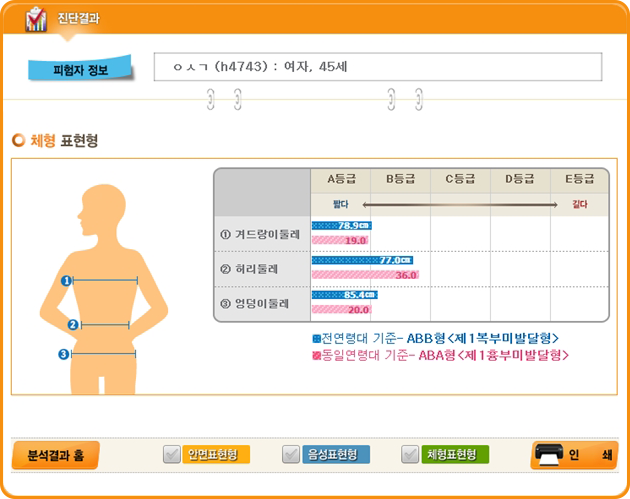
For example, a person who was diagnosed using SCAT2 has been determined to have 50% of the features of a Tae-eum type, 30% of the features of a So-yang type and 20% of the features of a So-eum type, with long and angular (rectangular) facial shape and angular and drooping eye shape. The person has also been diagnosed to have a voice measured at 44 in clarity, 21 in depth, and 68 in softness, as well as waist size of 36.
SCAT2, which adds CDSS to existing SCAT, is characterized by its provision of systemized and quantified information on facial, vocal, and body features necessary for the diagnosis of physical consitutional types by Korean medicine doctors.
With the reinforcement of CDSS in SCAT2, the Korean medicine doctors can now utilize objective data in determining constitutional types, and it is expected to improve public confidence in the diagnosis of Sasang constitutional types.
As detailed analysis of facial, vocal and body features is enabled, it is seen that the introduction of a personalized disease prevention and health management service will be expedited through follow-up studies on the correlation between physical constitutional types and the occurrence of various diseases.
Dr. Kim Jong-yeol, who headed the research team, said, "As detailed analysis of facial, vocal, and body features has been enabled, it is now possible to conduct follow-up studies to shed light on the correlation between physical constitutional types and the occurrence of diseases. We will do our best to expedite the development of an integrated system of personalized diagnosis-prognosis-treatment service, which is personalized based on their Sasang constitutional type."
Based on the results of the research, the research team has applied patents for 'Apparatus and Method for Determination of Facial Expression Type(application no.: 10-2014-0048689)', 'Apparatus and Method for Judgement of Body Type Development (application no.: 10-2014-0054214)' and 'Apparatus and Method for Diagnosis of Physical Conditions Using Phonetic Analysis (application no. 10-2014-0054082).'

Effects of Moxibustion on Treating Arthritis in the Knee Proven Scientifically
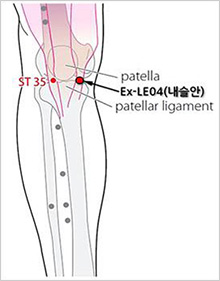 |
 |
Dr. Choi Sun-mi's research team at Korea Institute of Oriental Medicine (KIOM) has proved the effects of moxibustion, one of the key treatment methods in Korean Medicine, on treating arthritis of the knee.
Dr. Choi's team conducted a multicenter clinical study on arthritis of the knee at 3 Korean medical hospitals nationwide, and reported that moxibustion improved the Western Ontario and McMaster Universities Osteoarthritis (WOMAC) score by 25.6%.
The results of this clinical study were published in the 2014 August issue of PLoS ONE (IF : 3.53), a public science library journal in the U.S., attaining global recognition of the efficacy and safety of moxibustion treatment. This result not only eliminates doubts about the effects of moxibustion, but also confirms the excellence of Korean Medicine.
|
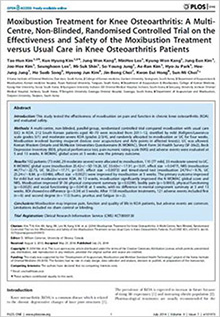 |
 |
Arthritis of the knee is one of the major joint arthritis diseases that results in higher medical and health management expenses due to pain, limited daily functions and deteriorated quality of life, including intra-articular inflammation, degeneration of cartilage and weakened muscular functions.
The clinical study was conducted as a multicenter study that was participated in by leading Korean medical hospitals, including KIOM Clinical Research Center, Gil Oriental Medical Hospital of Gachon University, Dongshin University Oriental Hospital, and Semyung University Oriental Medicine Hospital.
The study was performed on 212 patients diagnosed with arthritis in one or both knees through a radiation test. The test group given moxibustion treatment consisted of 102 subjects, while the control group that did not receive the treatment had 110 subjects.
|
The control group did not receive moxibustion treatment, but each subject was allowed to maintain their own treatments such as self-exercise therapies (light exercise, stretching, etc.) and daily maintenance activities (hot packs, medicated patches, etc.).
The test group received moxibustion treatment in addition to daily maintenance activities. A total of 12 sessions of moxibustion treatment was performed 3 times a week for 4 weeks on 6 acupoints: joksamri, dokbi, yanggu, eumreungcheon, naeseulan and hyeolhae.
In addition, if a patient had areas with pain on the knees, up to 2 Asi-points (trigger points more sensitive in the area with pain when pressed) were added for customized moxibustion treatment.
Assessment of the test group and control group was conducted at the beginning of the study (Week 1), at the end of the 4-week moxibustion treatment (Week 5) and 8 weeks after the treatment (Week 13).
Methods generally used in clinical studies - such as WOMAC score and measurement of quality of life - were utilized for the assessment.
* WOMAC is an index for measuring arthritis that was developed by research teams at Western Ontario University and McMaster University in Canada. Patients answer survey questions covering joint pain, stiffness and joint functions and rate their symptoms with a number from 0 and 96. The higher the number is, the more severe the symptoms are.
According to the study results, the control group that carried out daily maintenance activities recorded an average WOMAC of 34.16 in Week 1, 33.6 in Week 5 and 34.69 in Week 13, showing no significant differences over the course of the study. In contrast, the test group had an average WOMAC score of 34.15 in Week 1, 25.42 in Week 5 when the moxibustion treatment ended (a 25.6% decrease from Week 1) and 26.7 in Week 13, which was 8 weeks after the treatment (a 21.8% decrease from Week 1).
Moreover, the results from the Short Form (36) Health Survey (SF-36) evaluating the quality of life also demonstrated a significant difference between the control group and the test group in body pain (BP), physical function (PF) and social function (SF).
* The SF-36 is a survey asking questions about health status. It has been used as a barometer for many diseases thanks to its high reliability. It consists of eight sections: 1) physical functioning; 2) physical role functioning; 3) bodily pain; 4) general health perceptions; 5) emotional role functioning; 6) vitality; 7) social role functioning; and 8) mental health.
Dr. Choi claimed, "It is highly meaningful that we established scientific, objective grounds proving the clinical effectiveness of moxibustion treatment with the results from this study." Choi added, "We will continue to pursue clinical studies scientifically proving the effects and safety of non-drug treatment techniques such as acupuncture and moxibustion."

KIOM Transfers Technology to Treat Diabetic Retinopathy
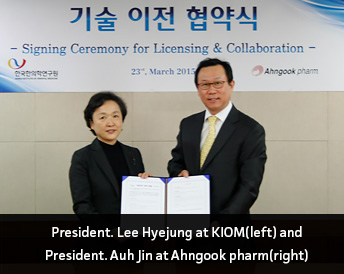
On April 23, 2015, a signing ceremony for licensing & collaboration was held between KIOM and Ahngook Pharmaceutical Co., Ltd. At the ceremony, Dr. Kim Jin Sook at Korea Institute of Oriental Medicine (KIOM) transferred the technology she developed to treat and prevent damage to the retinal vessels and optic nerve due to hyperglycemia in diabetic patients.
The result derived from the "Research on the Prevention and Treatment for Diabetic Complications Using Traditional Herbal Medicine" project for the Ministry of Science, ICT and Future Planning. Its Korean patent was granted in February 2015, and is application for the PCT is under progress.
|
 |
On April 23, 2015, a signing ceremony for licensing & collaboration was held between KIOM and Ahngook Pharmaceutical Co., Ltd. At the ceremony, Dr. Kim Jin Sook at Korea Institute of Oriental Medicine (KIOM) transferred the technology she developed to treat and prevent damage to the retinal vessels and optic nerve due to hyperglycemia in diabetic patients.
Diabetic retinopathy is a leading disease that leads to blindness. In 2013, the Australian Therapeutic Goods Administration (TGA) approved the use of fenofibrate that is used to treat hyperlipidemia to treat diabetic retinopathy. In Korea and most of other countries currently have no treatment for diabetic retinopathy.
It is expected that the licensing and collaboration between KIOM and Ahngook Pharmaceutical will lead the global pharmaceutical market for diabetic retinopathy treatment and contribute to the creative economy.
|
|
|



|
Korea Institute of Oriental Medicine (KIOM) held the opening ceremony on June 3 for the KM Application Center, which will act as a hub for industrial technology on Korean medicine, in the Daegu-Gyeongbuk Medical Cluster, Daegu City.
The KM Application Center, construction of which started in September 2013, was built on a 11,550m2 area. It has a laboratory building with three stories above and one story under ground, an animal lab, a dormitory, etc.
The center will focus on the development of application materials and new herbal dosage forms through convergence of Korean medicine and newest medical technologies such as bio-technology(BT) and nano-technology(NT), under the purpose of establishing the basis for the industrialization of Korean medicine.
In addition, the center will build and maintain the support network for small and medium companies in Daegu-Gyeongbuk region and carry out the role of a key point of local cooperation among industry, academia and research through joint R&D efforts to deal with the demands from local businesses.
President Lee Hyejung of KIOM commented, "The KM Application Center will carry out R&D activities based on the convergence of Korean medicine and other fields in cooperation with the Daegu-Gyeongbuk Medical Cluster to lead in the commercialization of Korean medicine technology. As a result, KIOM will take the leadership in the realization of creative economy through the promotion of Korean medicine industry and development of national medical industry."
|
|



Korean Medicine Clinical Practice Guidelines
Atopic Dermatitis / Facial Palsy / Lumbar Herniated Intervertebral Disc in Adults
Dr. Lee Myeong-soo's team at Korea Institute of Oriental Medicine (KIOM) published 'Korean Medicine Clinical Practice Guidelines' for atopic dermatitis, facial palsy and Lumbar Herniated Intervertebral Disc in Adults.
Dr. Lee's team chose atopic dermatitis, facial palsy and lumbar herniated intervertebral disc in adults as the diseases to develop the guidelines for, as they are in high demand in the Korean medical field.
The Korean Academy of Oriental Rehabilitation Medicine participated in developing the guidelines for the treatment of lumbar herniated intervertebral disc in adults, while the Korean Acupuncture & Moxibustion Medicine Society assisted in the guidelines for facial palsy, and the Academy of Korean Medicine Ophthalmology, Otolaryngology & Dermatology was active in developing the guidelines for atopic dermatitis.
'Korean Medicine Clinical Practice Guidelines' were developed by comprehensively gathering present grounds for Korean medical treatment techniques and the opinions of specialists in each disease. It provides Korean medical doctors with information to help them make logical and well-founded decisions.
'Korean Medicine Clinical Practice Guidelines' can be downloaded from KIOM's homepage (www.kiom.re.kr; Provided in Korean Language only).
The development of 'Korean Medicine Clinical Practice Guidelines' have allowed for scientific and systematic treatment of patients through Korean Medicine. This is expected to boost the quality of Korean medical services for the people.

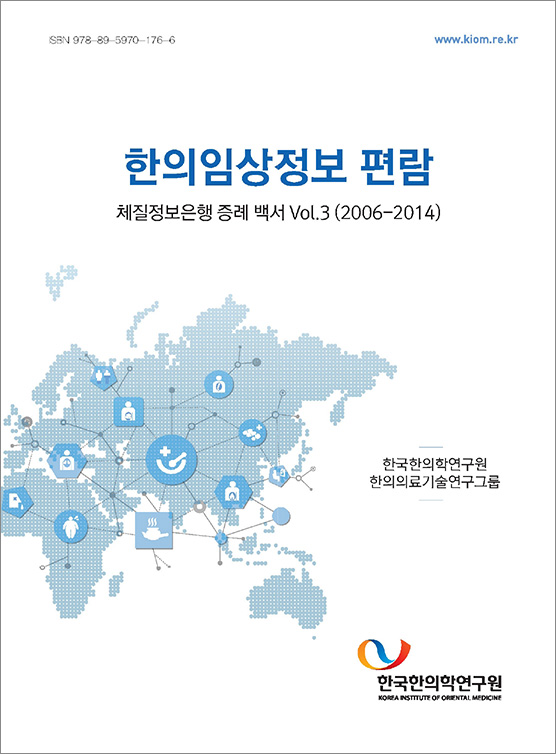 |
 |
KM Clinical Practice Information Handbook
Dr. Lee Siwoo and his team at Korea Institute of Oriental Medicine (KIOM) released 'KM Clinical Practice Information Handbook', a collection and analysis of the clinical, instrumental, and biological data of Sasang constitutions from approximately 16,000 Koreans and foreigners.
'KM Clinical Practice Information Handbook' has been put together for Sasang Constitutional Medicine-related clinical data in Korea and overseas, and for this, the clinical, instrumental, and biological data of Sasang constitutions from approximately 16,100 Koreans and 600 foreigners has been collected and analyzed.
Dr. Lee Siwoo and his team at Korea Institute of Oriental Medicine (KIOM) released 'KM Clinical Practice Information Handbook', a collection and analysis of the clinical, instrumental, and biological data of Sasang constitutions from approximately 16,000 Koreans and foreigners.
|
The clinical data of Sasang constitutions comprises of demographical data; surveys on personality and health; and data on ordinary symptoms (symptoms by the individual constitution), disease symptoms (signs of disease), and disease.
Under the instrumental data section, there are information on the subjects' body weight; measurements around eight body parts, such as the forehead, neck, chest, and waist; and widths of five body areas, such as the armpits, chest, and waist. In addition, there are video recordings of the frontal and side views of the faces and their voice recordings.
The biological data section contains data on complete blood tests and genomes.
The handbook was initiated in need of the systematic collection and management of clinical data on Sasang Constitutional Medicine.
For this, from 2006 to 2014, Dr. Lee and his team established a network between the multi-institutional clinical research network of Korean and foreign research institutes and regional cohorts.
For the handbook, 26 oriental medical institutes and major hospitals in Korea, such as Kyung Hee University Korean Medicine Hospital, Wonkwang University Oriental Medical Hospital, Oriental Hospital of Daejeon University, Ajou University Hospital, Korea University Medical Center, and Asan Medical Center, participated in gathering clinical data.
In addition, Tohoku University Hospital in Japan; Chaoxian Medicine Hostpital in Yanji, China; the National Hospital of Traditional Medicine in Hanoi, Vietnam; and the National College of Natural Medicine(NCNM) in Oregon, US, participated in the research.
Dr. Lee and his tim have been collected the clinical, instrumental, and biological data of Sasang constitutions from 2006 to 2014. Based on the statistics and data collected, the research team published 'Korea Constitutional Multicenter Bank (KCMB) Case (2006-2011)' in 2012, 'Korea Constitutional Multicenter Bank (KCMB) Case Vol. 2 (2006-2012)' in 2013, and 'KM Clinical Practice Information Handbook - Korea Constitutional Multicenter Bank (KCMB) Case Vol. 3 (2006-2014)' this year.
* The Constitutional Multicenter Bank refers to the standard sample database of Sasang constitutions, compiled by KIOM and 26 oriental medical institutes and clinics throughout Korea. The Constitutional Multicenter Bank contains information on approximately 16,000 subjects, whose constitutions have been accurately diagnosed by Sasang constitutional experts with more than 5 years of clinical experience. Some of the information include instrumental data, such as their faces, body shapes, and voices; surveys reflecting their physiological characteristics; clinical data, such as diagnoses by doctors of oriental medicine and drug reactions; and biological data, such as 32 types of blood analysis and information on genomes.
It is expected that the use of this handbook containing objective and systematic clinical data on Sasang constitutions by Korean and foreign researchers will pave the way for diverse clinical and mechanism research opportunities.
The research team's upcoming plan is to establish Korean Medicine Data Center for diverse KM clinical data in addition to clinical data on Sasang constitutions.
The handbook can be downloded on the KIOM website(www.kiom.re.kr; Provided in Korean language only).
|
|

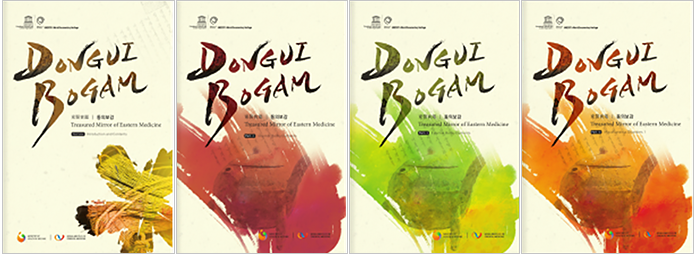
Donguibogam
Elevated to National Treasure This Year
Available in English
Donguibogam, literally meaning "Principles and Practice of Eastern Medicine", is an encyclopedic bible of medical knowledge and treatment techniques compiled in Korea in 1613. It is edited by Heo Jun under the collective support of medical experts and literati according to the royal instruction.
Donguibogam, one of the most significant book in Korean Medicine, was designated as the Memory of the World Register by UNESCO in 2013. And this year, Donguibogam is elevated to national treasure in 22 June.
Check out the English version of Donguibogam at our Cyber Donguibogam Museum Website.
|
|



|
From May 13 to 15, 2015, KIOM held the 10th International Congress of Complementary Medicine Research (ICCMR 2015), considered the largest international conference on traditional medicine, in Jeju Island, Korea.
ICCMR is considered one of the foremost international congresses on traditional, complementary, and integrative medicine at the globe, organized by the International Society for Complementary Medicine Research (ISCMR). ISCMR was initiated in 2003 as an academic gathering among North American and European researchers from countries including the United States, Canada, the United Kingdom, and Germany.
Under the theme of "Inspiring Future Healthcare: The innovative role and sustainable development of traditional and integrative medicine," the main objective of ICCMR 2015 was to discuss the possibilities and limitations of traditional, complementary, and integrative medicine for the development of future health care and to share the status of traditional, complementary, and integrative medicine research.
For the congress, around 600 people from approximately 30 countries in North America, Europe, and Asia gathered, and many of the participants were government officials, researchers, and clinical experts.
ICCMR 2015 comprised of 8 keynote lectures and 24 concurrent sessions on 5 categories: Basic Research, Clinical Research, Education, Health Service, and Research Methodology on Traditional and Integrated Medicine.
|

Keynote speakers were renowned systems biologist Denis Noble from Oxford University, UK; Dr. Heather Boon from the University of Toronto, Canada; Dr. Kiichiro Tsutani from the University of Tokyo, Japan; Dr. Adam Perlman of Duke Integrative Medicine, US; Vice President Liu Baoyan of China Academy of Chinese Medical Sciences; Dr. Peter M. Wayne from Harvard Medical School, US; Dr. Choi Woncheol from Dankook University, Korea; and Dr. Choi Sunmi, Executive Director of R&D of KIOM, Korea.
For the congress, around 430 abstracts were submitted from around 30 countries, including the United States, Australia, Japan, the United Kingdom, and Germany. Among them, approximately 100 abstracts were chosen for oral presentations and 300 for poster presentations.
 |
 |
For the congress, eminent scholars and representatives from various Korean and foreign institutes participated for presentations and discussions on different topics. Some of the participated institutes were the Society of Sasang Constitutional Medicine (Korea), Kyung Hee University East-West Medical Research Institute (Korea), Dunsan Korean Medicine Hospital of Daejeon University (Korea), the National Institute on Alcohol Abuse and Alcoholism (US), Kitasato University (Japan), and the University of Technology, Sydney (Australia).
|
Having experts of traditional medicine, complementary medicine, and integrative medicine in one place, ICCMR 2015 served as a valuable opportunity not only for a global network but also to share recent research achievements and the latest trends of each country.

|

KIOM Held International Forum for Experts of Traditional Medicine
On May 12, 2015, an international forum under the theme of "Expert Consultation on Traditional and Complementary Medicine Integration with National Health Care Systems" was held in Jeju, bringing together experts of health care and traditional medicine from nine countries, including the United States, the United Kingdom, and Switzerland.
The forum was chaired by Korea Institute of Oriental Medicine (KIOM), and co-hosted by the Ministry of Health & Welfare and the World Health Organization Regional Office for the Western Pacific (WHO-WPRO).
The forum introduced Korea's health care system, which includes traditional medicine as part of the national medical system, and the participants exchanged ideas on systematic and financial support required to integrate traditional medicine with the national health care systems.
|
|


 |
 |
Integrative Medicine Research (IMR) is a quarterly, peer-reviewed journal focused on scientific research for integrative medicine including traditional medicine (emphasis on acupuncture and herbal medicine), complementary and alternative medicine, and systems medicine. The journal publishes Editorials, Review Articles, Original Articles, Case Reports, Letters to the Editor, Commentaries, and Study Protocols.
IMR welcomes article submissions. Articles may be submitted at any time and are reviewed on a rolling basis, and there are no submission or publication fees. Manuscripts for IMR may be submitted via Elsevier Editorial System (http://ees.elsevier.com/imr). For editorial questions, please contact us via email at imr@kiom.re.kr, telephone (+82 42 868 9392), or fax (+82 42 869 2720).
Check out more about the journal at our homepage.

|
|
|
|
| |
KOREA INSTITUTE OF ORIENTAL MEDICINE
1672 Yuseong-daero, Yuseong-gu, Daejeon, 34054, Republic of Korea
Tel. +82-42-868-9477 Fax. +82-42-868-9616
|
| |
|
|